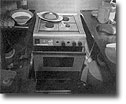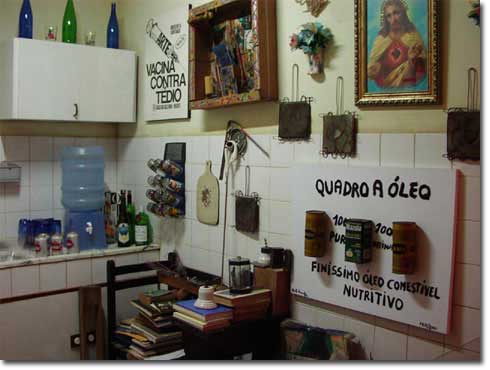Bienal de Sí¢o Paulo ,
Sep 01, 2004 - Dec 01, 2004
SÃ o Paulo, Brazil
Scenes from the Sço Paulo International Biennial
by Viviana Usubiaga
In the second group we place Thomas Demand (Representing Germany), whose works concentrate on the simulation of various scenes. Together with architect Arno Brandlhuber, Demand planned a site within the Biennial, forming an exhibition within an exhibition. Next to the building’s escalator is a semi-enclosed hall that contrasts with the expansive view from the central ramp of the pavilion, one of its characteristic elements. Within this "parasitic space" he places a series of photographs and a screening room of the same size as another on the third floor, giving the visitor a space that is familiar, yet completely out of context. The basic element of Demand’s artistic plan is the effect of ad hoc duplication, generated by both exhibition spaces and within each of his photographs. The artist volumetrically recreates space-scenes on paper and cardboard and utilizes the photographic medium to record these ephemeral models at true scale. The final photographs are scenes with an unusual and unstable subject matter, taken from the public photographic archives. The scenes appear to have no outstanding feature, however, they show places that for some reason acquired a relevant cultural significance. They appear to be uninhabited spaces, unexpressive in appearance but evoking pathetic events or situations about which the artist gives no information. These scenes were previously circulated, but Demand’s specific duplications are altered due to the play between the mobility of the objects and their technical reproduction. This is true of the work Cocina, which shows a fragment of a house and based on a photograph of the kitchen at Saddam Hussein’s hideout during the U.S. invasion of Iraq in 2003. The screening room shows the film Truco, based on a Lumiére brothers’ film which, according to Douglas Fogle, the artist exemplifies a transitional phase between routine everyday documentation and the birth of a fictional narrative. These works, working within the larger installation, appeal to a visual estrangement between plan and volume, and play on the uncertainty of perception. Demand makes his own rules and limitations within the simulacrum, taking over spaces measured by images and then, in his reconstruction, removing from them any clue as to their actual locations, falsifying their materiality but respecting the original scale. The materials of the piece are extracted from their environment to subsequently give way to artifice, corrupting the mnemonic dimension of the icons. On producing an image immortalized by photography, the content becomes perennial in order to achieve re-immortalization through appearances only and question the viewer’s experience of reality.
For his part, Miguel Calderón (Mexican representative), created a scene from a fictitious football match between Mexico and Brazil. Assimilating the television transmission codes, he smartly chose to place his work within the Biennial snack bar, in the manner of a sport video-bar. This would pass unnoticed by a visitor uninterested in sport, if it was not for the fact that the game became more improbable with each passing moment. Mexico finally beat the Brazilian team, 17 goals to zero. The farce unfolded through a careful editing process of the footage and became the material on which the video was based, as did its location which contributed to the effectiveness of the deceit.
Thirdly, we look at works referring to projects whose development and process, became part of their staging. This is the case with Yin Xiuzhen (Chinese guest artist), who prepared a setting that remained as part of the installations, when the performance was over. During the opening of the Biennial, several Chinese and Brazilian seamstresses with sewing machines manufactured cloth models of towns constructed in various ways. Blandly erected little houses and large towers had snippets of used clothing attached. The work, entitled Shopping , shows the changes in the appearance of the urban landscape that arose from the introduction of large shopping centers within the global economy. These fictitious townships with their flimsy buildings, warping as they rose higher, established ambiguous relationships between the attempted development of cities internationally and industrial manufacturing. The walls and landscape of clothes are impregnated by the sweat of those who once wore them. Even when the performers were not "working" the presence of the idle machines and their empty seats, like a vacant stage, gave rise to other sensations.
The last case is that of another Chinese artist, Song Dong (guest artist), in which the transformation and staging of an absence is also significant. The installation consisted of a large blue canvas measuring 10 x 10 meters on which a map of the world is reproduced by bits of food, like an enormous tablecloth on which delicacies are served, inviting visitors to devour the world. The artist carried out a similar Project in 2003, when he constructed a map of the city of Shanghai from scraps of food. In São Paulo, after the public had left, what remained of the work - an empty ocean with demolished continents - emphasized only their absence during the remainder of the Biennial. Only the title of the project Eating the World, written on the wall, gave a clue as to the artist’s intentions, thus leaving only the pillage as evidence of his work.
In all these cases, it would appear that the use of new forms as possible new scenarios is in tune with the "culture of activity" of late capitalism. As the English artist Liam Gillick stated: "The production of scenarios is one of the principal elements that helps maintain a level of mobility and invention, required by the dynamics of so-called market economics". This selection of works does not pretend to be either strict or exhaustive; various other productions at the Biennial could be included within the three categories mentioned. Perhaps one’s attention is attracted to these items as the most evident or effective examples of scenarios in the hazardous fields of contemporary art.
|













